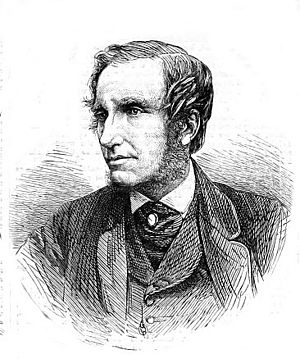Edward William Cooke facts for kids
Edward William Cooke (born March 27, 1811 – died January 4, 1880) was a talented English artist. He was known for painting beautiful landscapes and scenes of the sea, especially ships. He was also a keen gardener.
Life of a Painter
Edward William Cooke was born in Pentonville, London. His father, George Cooke, was a famous engraver. An engraver is someone who carves designs onto metal plates to make prints. Edward grew up surrounded by artists, including his uncle, William Bernard Cooke, who was also a skilled engraver.
Edward showed artistic talent from a very young age. He was a great draughtsman (someone who draws well) and engraver. When he was just 18, in 1829, he published a collection of his engravings called "Shipping and Craft." This book showed his love for ships and the sea.
He learned a lot from his father's artist friends, like Clarkson Stanfield and David Roberts. Cooke started painting with oil paints in 1833. He took lessons from James Stark in 1834. By 1835, he was already showing his paintings at important art shows like the Royal Academy.
Early Art and Travels
Even when he was only four years old, Edward William Cooke drew many pictures of ships, boats, and coastal views. Some of his early drawings were inspired by Dutch artists who painted countryside scenes and animals.
Cooke loved to travel and paint. He visited the Netherlands in 1837 because he admired Dutch marine artists from the 1600s. He went back to the Netherlands many times over the next 23 years. He studied the coastal landscapes and the way light looked there. He also studied the works of famous Dutch painters, which helped him create very successful paintings. One of his famous works, 'Beaching a Pink at Scheveningen', was shown at the Royal Academy in 1855.
He also traveled to Scandinavia, Spain, North Africa, and especially to Venice, Italy. In 1858, he became an Honorary Academician at the National Academy of Design.
Cooke was very fond of the Isle of Wight in England. During a visit in 1835, he carefully studied fishing boats and lobster pots. He especially loved painting beaches covered with rocks, fishing gear, and small wooden jetties (piers).
Beyond Painting
Edward William Cooke had many interests besides art. He was very interested in natural history and geology (the study of Earth's rocks and soil). He was a member of several important scientific groups, including the Linnean Society and the Geological Society.
In the 1840s, he helped his friend, James Bateman, design the beautiful gardens at Biddulph Grange in Staffordshire. He helped with the sections for orchids and rhododendrons. His interest in geology led him to become a Fellow of the Royal Society in 1863. The next year, he became a Royal Academician, which is a very high honor for an artist in England.
In 1842, a scientist named John Edward Gray even named a type of boa snake, Corallus cookii, after Cooke to honor him!



